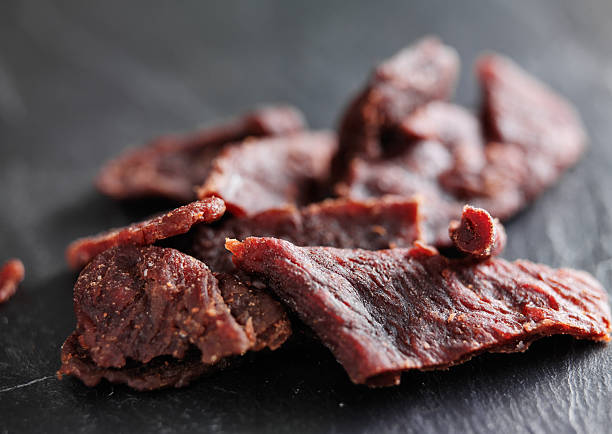Beef jerky: it’s the protein-packed, shelf-stable snack beloved by hikers, road trippers, and gourmet foodies alike. Yet, a glance at the price tag can often leave consumers wondering why this dehydrated meat commands such a premium. The high cost of beef jerky is not just a matter of market demand; it is the culmination of a series of factors that impact its production, quality, and distribution.
In our insightful article, “Why Is Beef Jerky So Expensive,” we delve into the meaty details of beef jerky’s pricing. Our deep dive into the world of jerky is backed by a thorough understanding of the food industry, shedding light on the economic and logistical elements that contribute to the cost of producing this savory snack. From the choice cuts of beef used to the lengthy dehydration process, we examine each step that adds value – and expense – to the final product.
This article is not just a cost breakdown; it’s a narrative that demonstrates the value behind every ounce of beef jerky. We explore how traditional practices, modern innovations, and consumer expectations intertwine to influence the price. Whether you’re a casual snacker curious about the cost or an entrepreneur pondering entry into the jerky market, there’s a wealth of knowledge to uncover.
We’ve crafted content that not only establishes our expertise on the topic but also engages your curiosity about the wider economic and gastronomic contexts of beef jerky. By the end of this article, you’ll have a new appreciation for the intricate journey from pasture to packet and the complex interplay of factors that make beef jerky a luxury item in the snack world.
So, as you embark on this flavorful exploration, be prepared to have your curiosity satisfied. You’re about to discover the surprising intricacies behind the high cost of beef jerky, and why this snack is more a gourmet delight than a simple treat. Join us as we unravel the secrets behind the price tag and answer the burning question: Why is beef jerky so expensive?
Contents
The Costs Behind Beef Jerky’s Price Tag
Ingredients – The Building Blocks
At its core, jerky is just spiced and dried steak. So the beef itself is a major ingredient cost.
- Beef Prices – Comparing Cuts
The cut of beef makes a big difference. Tougher cuts like flank steak or bottom round suitable for jerky typically cost $7-12 per pound. More marbled brisket can be cheaper but produces a fattier final product. - Quality Considerations
You get what you pay for with beef. Higher quality grass-fed or organic beef can significantly increase costs but results in a superior tasting jerky. The origin and breed of cattle also impact price. - Spices and Flavors
Whether made with natural spices or artificial flavors, seasonings add cost as well. Natural ingredients are pricier but preferred by many jerky enthusiasts.
Processing Costs – From Raw to Ready
Turning raw beef into shelf-stable jerky requires specialized processing, which contributes to the final cost.
- Dehydration vs. Smoking
Traditional smoking or modern dehydrators both effectively dry meat, but require expensive equipment and energy. Time is money too – drying takes hours or days. - Labor Intensity
Lots of labor goes into slicing beef, preparing marinades, monitoring drying, and packaging. This manual effort increases production costs.
Market Factors – Supply, Demand, and Competition
Basic economics also play a role in jerky’s price.
- When demand rises or supply drops, jerky producers can charge more.
- Well-known brands can leverage their reputation to command higher prices. New competitors have to undercut them to attract customers.
- Where jerky is sold affects cost too. Online and specialty shops have higher overhead than basic grocery stores.
Quality vs. Price – Factors to Consider
- Lean Cuts and Fat Content
Higher quality jerky comes from leaner cuts. Fatty jerky has a shorter shelf life. So those premium lean cuts cost more up front. - Preservatives and Additives
Jerky without preservatives often costs more due to its shorter shelf life. Mass market brands use additives to reduce costs. - Health Benefits
For some consumers, jerky’s protein content and lack of unhealthy ingredients justify its higher cost compared to other snacks.
Additional Reasons for the High Cost

- Long Shelf Life
When stored properly, jerky can last months or even years – increasing its value. - Convenience and Portability
Jerky is the perfect portable protein. That makes it worth the price for hikers, road trippers, and outdoor adventurers. - Sustainably Sourced
Ethical, sustainable farming practices or wild game meat can significantly increase costs but appeal to certain jerky lovers.
Grades of Jerky
Higher grade “gourmet” or “craft” jerkies are held to stricter quality standards and cost more than mass-produced products. Discerning jerky connoisseurs feel the premium is justified.
International Comparisons
Depending on the country or region, jerky prices fluctuate based on local costs like meat prices, labor, and transportation. In some areas beef is cheaper or jerky consumption less common, reducing costs.
Conclusion
In the end, producing premium jerkies with high-quality ingredients, specialized processing, and artisan techniques drives up costs. But many jerky junkies think the tender, flavorful results are worth every penny. Satisfying your jerk cravings just comes with a steep price tag.

Trayce served as a grassroots leader and activist in Texas as President of Dallas and Texas Eagle Forum.
Trayce is Mom Caucus Member, Texas Conservative Mamas, Texas Conservative Grassroots Coalition Leader, and Grassroots America Champion of Freedom Honoree.
She currently serves as the Eagle Forum National Issues Chair on Human Trafficking.
Trayce received a Bachelor’s Degree in Marketing from Texas A&M
Currently, she homeschools her youngest child age 13 and graduated her six oldest children, ages 31 to 19.







